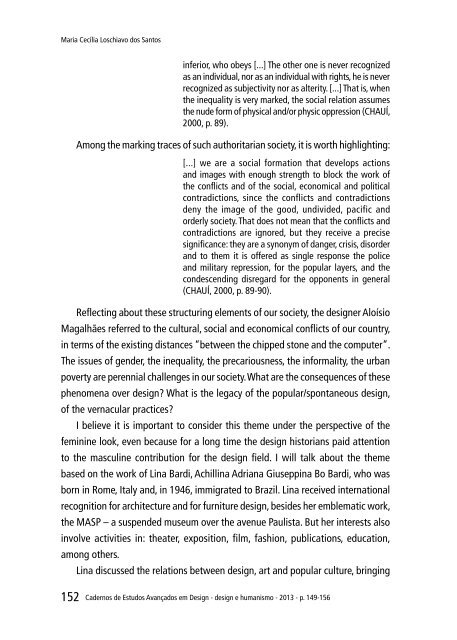o_19po8js951tvs1r0t1r8s4bb1vpla.pdf
You also want an ePaper? Increase the reach of your titles
YUMPU automatically turns print PDFs into web optimized ePapers that Google loves.
Maria Cecília Loschiavo dos Santos<br />
152<br />
inferior, who obeys [...] The other one is never recognized<br />
as an individual, nor as an individual with rights, he is never<br />
recognized as subjectivity nor as alterity. [...] That is, when<br />
the inequality is very marked, the social relation assumes<br />
the nude form of physical and/or physic oppression (CHAUÍ,<br />
2000, p. 89).<br />
Among the marking traces of such authoritarian society, it is worth highlighting:<br />
[...] we are a social formation that develops actions<br />
and images with enough strength to block the work of<br />
the conflicts and of the social, economical and political<br />
contradictions, since the conflicts and contradictions<br />
deny the image of the good, undivided, pacific and<br />
orderly society. That does not mean that the conflicts and<br />
contradictions are ignored, but they receive a precise<br />
significance: they are a synonym of danger, crisis, disorder<br />
and to them it is offered as single response the police<br />
and military repression, for the popular layers, and the<br />
condescending disregard for the opponents in general<br />
(CHAUÍ, 2000, p. 89-90).<br />
Reflecting about these structuring elements of our society, the designer Aloísio<br />
Magalhães referred to the cultural, social and economical conflicts of our country,<br />
in terms of the existing distances “between the chipped stone and the computer”.<br />
The issues of gender, the inequality, the precariousness, the informality, the urban<br />
poverty are perennial challenges in our society. What are the consequences of these<br />
phenomena over design? What is the legacy of the popular/spontaneous design,<br />
of the vernacular practices?<br />
I believe it is important to consider this theme under the perspective of the<br />
feminine look, even because for a long time the design historians paid attention<br />
to the masculine contribution for the design field. I will talk about the theme<br />
based on the work of Lina Bardi, Achillina Adriana Giuseppina Bo Bardi, who was<br />
born in Rome, Italy and, in 1946, immigrated to Brazil. Lina received international<br />
recognition for architecture and for furniture design, besides her emblematic work,<br />
the MASP – a suspended museum over the avenue Paulista. But her interests also<br />
involve activities in: theater, exposition, film, fashion, publications, education,<br />
among others.<br />
Lina discussed the relations between design, art and popular culture, bringing<br />
Cadernos de Estudos Avançados em Design - design e humanismo - 2013 - p. 149-156



